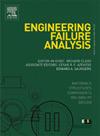基于渗碳齿轮疲劳寿命和失效机理的疲劳可靠性分析方法
IF 4.4
2区 工程技术
Q1 ENGINEERING, MECHANICAL
引用次数: 0
摘要
齿轮是机械产品中的重要部件之一,其疲劳可靠性决定了机械产品的安全性能。本文利用齿轮接触疲劳试验机研究了不同扭矩和恒定转速条件下渗碳齿轮的疲劳特性,并结合啮合齿轮副表面的动态最大接触应力分布,建立了应力比为-1条件下渗碳齿轮的超高循环疲劳P-S-N曲线。在最大接触应力和残余应力的共同作用下,渗碳齿轮表面或次表面的局部应力集中会引起晶粒位错运动,并在受到晶界阻碍后引起位错堆积和跨晶断裂,最终导致齿轮点蚀和疲劳失效。基于位错能量法,结合齿轮的疲劳失效机理,考虑动载荷、晶粒尺寸、初始裂纹长度、残余应力、滑移带长度和宽度等因素的相互作用,建立了具有良好预测效果的齿轮寿命预测模型。在考虑了寿命预测模型的齿轮寿命状态方程的基础上,建立了齿轮疲劳可靠性分析方法。通过进一步分析转速、晶粒尺寸、残余应力、滑移带宽度、滑移带长度和初始裂纹尺寸对齿轮疲劳寿命可靠性指标的影响,得出结论:齿轮的疲劳可靠性不仅随着上述参数的增加而降低,而且随着时间的增加呈下降趋势。这对于评估超高循环疲劳条件下齿轮的疲劳可靠性具有重要意义。本文章由计算机程序翻译,如有差异,请以英文原文为准。
Fatigue reliability analysis methodology based on fatigue life and failure mechanism for carburized gear
Gears are one of the important components in mechanical products, and their fatigue reliability determines the safety performance of mechanical products. In this paper, the fatigue characteristics of carburized gears under different torque and constant rotational speed conditions are investigated by using a gear contact fatigue testing machine, and combined with the dynamic maximum contact stress distribution on the subsurface of the meshing gears, the very-high cycle fatigue P-S-N curves of carburized gears under a stress ratio of −1 is established. Local stress concentration in the surface or subsurface of carburized gears causes grain dislocation movement under the combined influence of maximum contact and residual stresses, and then causes dislocation pileup and transcrystalline rupture after being hindered by grain boundaries, ultimately leading to pitting and fatigue failure of gears. Based on the dislocation energy method and combined with the fatigue failure mechanism of gears, a life prediction model of gears with good prediction results is established by considering the interaction of factors such as dynamic load, grain size, initial crack length, residual stress, slip band length and width. A fatigue reliability analysis method of gears is established based on the life state equation of gears considering the life prediction model. Further analyses of the influence of rotational speed, grain size, residual stress, slip band width, slip band length and initial crack size on the fatigue life reliability index of the gears resulted in the conclusion that the fatigue reliability of the gears not only decreases with the increase of the above-mentioned parameters, but also shows decreasing trend with the increase of time. This is of significance for evaluating the fatigue reliability of gears under very-high cycle fatigue conditions.
求助全文
通过发布文献求助,成功后即可免费获取论文全文。
去求助
来源期刊

Engineering Failure Analysis
工程技术-材料科学:表征与测试
CiteScore
7.70
自引率
20.00%
发文量
956
审稿时长
47 days
期刊介绍:
Engineering Failure Analysis publishes research papers describing the analysis of engineering failures and related studies.
Papers relating to the structure, properties and behaviour of engineering materials are encouraged, particularly those which also involve the detailed application of materials parameters to problems in engineering structures, components and design. In addition to the area of materials engineering, the interacting fields of mechanical, manufacturing, aeronautical, civil, chemical, corrosion and design engineering are considered relevant. Activity should be directed at analysing engineering failures and carrying out research to help reduce the incidences of failures and to extend the operating horizons of engineering materials.
Emphasis is placed on the mechanical properties of materials and their behaviour when influenced by structure, process and environment. Metallic, polymeric, ceramic and natural materials are all included and the application of these materials to real engineering situations should be emphasised. The use of a case-study based approach is also encouraged.
Engineering Failure Analysis provides essential reference material and critical feedback into the design process thereby contributing to the prevention of engineering failures in the future. All submissions will be subject to peer review from leading experts in the field.
 求助内容:
求助内容: 应助结果提醒方式:
应助结果提醒方式:


